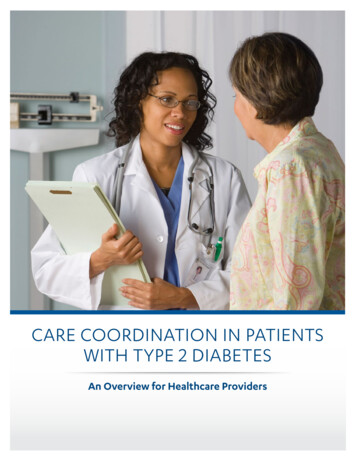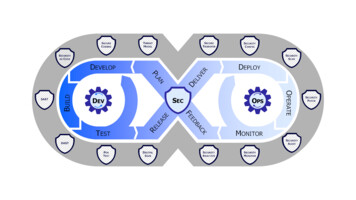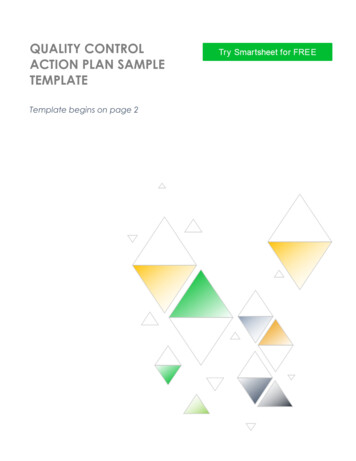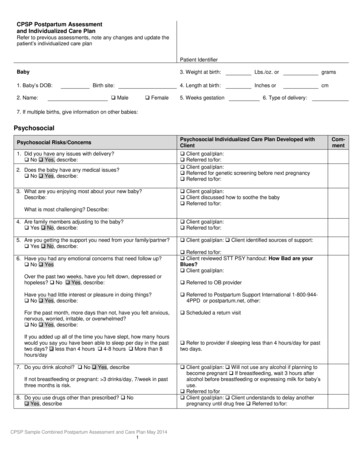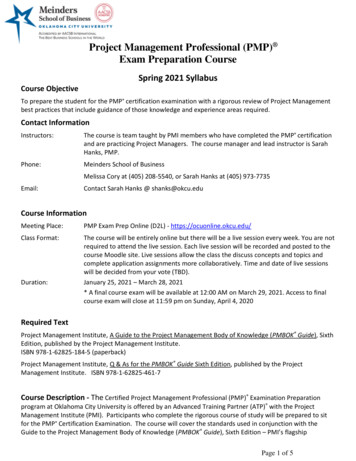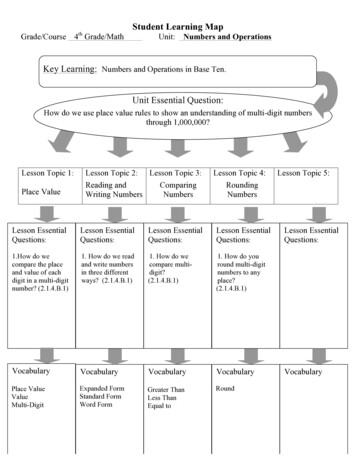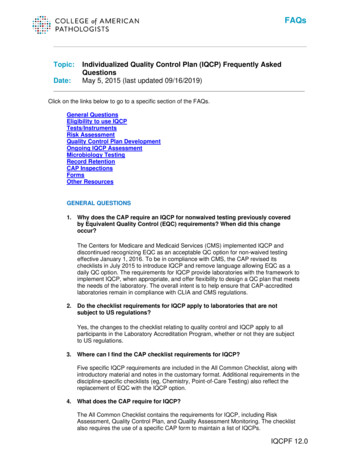
Transcription
FAQsTopic:Date:Individualized Quality Control Plan (IQCP) Frequently AskedQuestionsMay 5, 2015 (last updated 09/16/2019)Click on the links below to go to a specific section of the FAQs.General QuestionsEligibility to use IQCPTests/InstrumentsRisk AssessmentQuality Control Plan DevelopmentOngoing IQCP AssessmentMicrobiology TestingRecord RetentionCAP InspectionsFormsOther ResourcesGENERAL QUESTIONS1.Why does the CAP require an IQCP for nonwaived testing previously coveredby Equivalent Quality Control (EQC) requirements? When did this changeoccur?The Centers for Medicare and Medicaid Services (CMS) implemented IQCP anddiscontinued recognizing EQC as an acceptable QC option for non-waived testingeffective January 1, 2016. To be in compliance with CMS, the CAP revised itschecklists in July 2015 to introduce IQCP and remove language allowing EQC as adaily QC option. The requirements for IQCP provide laboratories with the framework toimplement IQCP, when appropriate, and offer flexibility to design a QC plan that meetsthe needs of the laboratory. The overall intent is to help ensure that CAP-accreditedlaboratories remain in compliance with CLIA and CMS regulations.2.Do the checklist requirements for IQCP apply to laboratories that are notsubject to US regulations?Yes, the changes to the checklist relating to quality control and IQCP apply to allparticipants in the Laboratory Accreditation Program, whether or not they are subjectto US regulations.3.Where can I find the CAP checklist requirements for IQCP?Five specific IQCP requirements are included in the All Common Checklist, along withintroductory material and notes in the customary format. Additional requirements in thediscipline-specific checklists (eg, Chemistry, Point-of-Care Testing) also reflect thereplacement of EQC with the IQCP option.4.What does the CAP require for IQCP?The All Common Checklist contains the requirements for IQCP, including RiskAssessment, Quality Control Plan, and Quality Assessment Monitoring. The checklistalso requires the use of a specific CAP form to maintain a list of IQCPs.IQCPF 12.0
FAQsMaster and custom versions of the checklists are available for download from cap.orgthrough e-LAB Solutions Suite (log in required).5.Is there a specific model and/or forms that I need to use to create my own IQCP?Can I use a commercial product to develop an IQCP?The CAP does not require a specific format for creating an IQCP. Laboratories maydevelop their own model for designing an IQCP or use other resources, such as theCDC/CMS guide (Developing an IQCP: A Step-by-Step Guide), CLSI Guideline EP23-A(Laboratory Quality Control Based on Risk Management), CMS guidance andbrochures, a manufacturer protocol, or other commercially available products.No specific forms are required when creating an IQCP; however, the CAP does requirethe use of a special form to list all IQCPs in use to facilitate the inspection process.Refer to the List of Individualized Quality Control Plans form located in the IQCPToolbox on cap.org in e-LAB Solutions Suite (log in required).6.Can I submit an IQCP developed by my laboratory to the CAP Central Office orto one of the CAP’s scientific resource committees for review and approval priorto implementation?No. The College of American Pathologists (CAP) does not offer this type of consultingservice. It is the laboratory director’s responsibility to review the IQCP risk assessmentand approve the quality control plan prior to implementation. For CAP-accreditedlaboratories, records for IQCPs implemented will be reviewed for compliance duringthe laboratory’s next onsite inspection.The CAP provides a number of resources to aid in the development andimplementation of an IQCP, including the checklist requirements (refer to FAQ #58 fora list of CAP and other resources).Back to topELIGIBILITIY TO USE IQCP7.Does IQCP apply to all types of testing? What are the CAP’s IQCPeligibility requirements?IQCP does not apply to waived testing. Laboratories must continue to followmanufacturer’s instructions for QC for both waived and nonwaived test systems, at aminimum.For nonwaived testing, the CAP has defined eligibility requirements for IQCP. Eligibilityis limited to tests meeting both of the following criteria:1.2.The testing is performed in a discipline other than Anatomic Pathology (ANP)or Cytopathology (CYP). (Exception: tests in ANP or CYP that can beassigned to another discipline) andThe test system has an internal control process (electronic, procedural or built-in).(Exceptions exist in microbiology for media, ID systems and susceptibilitytesting, which qualify for IQCP even though there is no internal QC.)For tests that do not meet the CAP IQCP eligibility requirements, the minimum dailyQC requirements and default CLIA regulations, as defined in the CAP checklist mustbe observed.IQCPF 12.0
FAQsThe CAP has developed an eligibility determination tool to assist in the determinationof eligibility of a test system for a CAP IQCP. It is available in the IQCP Toolbox oncap.org in e-LAB Solutions Suite (log in required).8.Can an IQCP be used to reduce the frequency of calibration, AMRverification, or instrument comparison?No. IQCP is applicable to QC only. The results and data from the above functions maybe useful when conducting the Risk Assessment for an IQCP.9.Is Microbiology testing eligible for IQCP?The following types of microbiology testing are eligible for IQCP: Molecular-based infectious disease testing and direct antigen testingperformed using nonwaived instruments or devices that have internal controlprocesses. Microbiology testing performed using media, identification systems, andsusceptibility test systems.Laboratories must have an IQCP to define the use of reduced QC, even if followingmanufacturer’s instructions or Clinical and Laboratory Standards Institute (CLSI)guidelines. Previous data collected by the laboratory and manufacturer certificates ofanalysis may be used in the risk assessment. Without an IQCP, the minimum CAPchecklist and default CLIA QC requirements must be followed.Refer to the Microbiology Testing section (FAQs #41 - 50) for additional questions andanswers on this topic.10. How do I determine if an internal control process used by my instrument ordevice is sufficient to meet the CAP’s eligibility criteria to implement anIQCP?The sufficiency of an internal control process must be evaluated by the laboratory as itperforms a risk assessment. The laboratory must evaluate the manufacturer’sinformation to identify potential areas of risk, processes to mitigate risk (eg, internalcontrol processes) and other sources of information, as available, and perform its ownstudies in its own environment to confirm that the defined control processes,frequency, and associated risk is acceptable. Retrospective data may be used in therisk assessment.11. Do all states allow IQCP?State regulations may vary from state to state. Laboratories that are unsure of IQCPacceptability in their state should contact the state CLIA office to confirm acceptabilityof IQCP in the state or determine if there are any limitations. If state law does not allowfor the use of the IQCP option, laboratories must follow the default QC requirementsdefined in the CAP checklist requirements, CLIA regulations, and applicable staterequirements, whichever is the most stringent.Back to topTESTS/INSTRUMENTS12. Are there any test systems or instruments that are exempt from IQCP?The CAP has not categorized any specific instruments or test systems as exempt fromIQCPF 12.0
FAQsIQCP.The use of an IQCP is voluntary and there are specific eligibility criteria defined for use.If an IQCP is not implemented for eligible tests, laboratories must follow the minimumdaily QC requirements and default CLIA regulations for daily QC of nonwaived testing,as defined in the CAP checklist. This will primarily impact laboratories that are usinginstruments or devices (eg, test kits) where an internal control process (electronic,procedural, or built-in) has been used for daily QC in lieu of an external quality controlsample, especially those that use multiple identical instruments or devices.13. Do I need to implement an IQCP if I am currently running at least two levels ofexternal QC for a nonwaived test each day of patient testing (or following morestringent requirements as defined in the CAP checklist and CLIA regulations)?No. There is nothing further you must do. If a test is eligible for an IQCP, the laboratoryis NOT required to implement an IQCP, but has the option to implement an IQCP orfollow the default QC requirements of at least two levels of external QC each day oftesting (or more frequent as specified in a discipline or subdiscipline).14. If my instrument has a control process that uses liquid control materials onboard the instrument or within a test cartridge, or uses a device, such as anoptical filter or electronic control simulator, do I need to implement an IQCPto meet daily QC requirements?The default CLIA regulations were written for the traditional daily testing of two levels ofexternal control materials. To be considered an external control material, the controlmaterial must have a similar matrix to that of patient specimens, be treated in the samemanner as patient specimens, and go through all elements of the analytic process asapplicable. It must also be a different type of material or from a different lot number thanused to calibrate the instrument (42CFR493.1256(d)(9)). Function checks,instrument/electronic checks, and procedural controls do not meet the definition of anexternal control material. Those types of checks only verify electronic components ordetect function of the instrument and may only monitor a portion of the analytic process.Laboratories must carefully evaluate the control processes used to determine if theycontrol the full analytic testing process.If the control process does not meet the criteria described for external control materials,the laboratory must either perform additional QC testing using appropriate externalcontrol materials or implement an IQCP to meet daily QC requirements. For on-boardinstrument controls that meet the above definition of an external control material, but varyin the preanalytic portion, such as with sampling of the control, an IQCP is not required.The laboratory can periodically verify proper sampling through proficiency testing,competency assessment, the use of other types of external control materials, andfollowing processes defined in the manufacturer’s instructions, as applicable.15. If I perform tests where there are no external control materials available, do Ineed to implement an IQCP?No, if no external control materials are available, the laboratory must establish its ownprocedures for detecting errors and monitoring test performance. An IQCP is notrequired, although the risk assessment process may aid a laboratory in identifyingpotential risk and developing an effective QC plan. Some examples of tests withoutexternal control materials include tests for cold agglutinins and for platelet function testingusing methods in which normal donor samples are the only source for verifying theIQCPF 12.0
FAQssystem’s performance. Laboratories must follow manufacturer’s instructions for qualitycontrol at minimum.16. If an IQCP is not used, what are the CAP’s minimum requirements anddefault CLIA regulations for daily external QC for nonwaived testing?Generally, the CAP and CLIA require at least two levels of external QC each day ofpatient testing. Different CAP and CLIA requirements exist in some discipline andsubdiscipline areas (eg, coagulation, blood gases, microbiology). The QCrequirements for non-waived testing, as written in the CAP checklists and CLIAregulations, must be followed if IQCP is not implemented.17. What are the QC requirements if I have multiple identicalinstruments/devices/cartridges in use but do not wish to develop an IQCP?Generally, the CAP and CLIA require at least two levels of external QC for eachdevice and cartridge, each day of testing. Different CAP and CLIA requirements existin some discipline and subdiscipline areas (eg, coagulation, blood gases, andmicrobiology). The QC requirements for nonwaived testing, as written in the CAPchecklists, must be followed if an IQCP is not implemented by January 1, 2016.18. Is an IQCP needed in flow cytometry for leukemia/lymphoma paneltesting?No. An individualized quality control plan (IQCP) is not required forleukemia/lymphoma immunophenotyping performed using flow cytometry. The FlowCytometry Checklist requirement FLO.23737 defines the quality control requirementsand the types of controls that may be used. As long as a laboratory has writtenguidelines defining criteria for acceptable performance of these controls and records ofperiodic performance, the CAP will consider the laboratory in compliance.19. Is an IQCP needed for molecular-based testing performed by mylaboratory?The IQCP option is limited to test systems that employ an internal(electronic/procedural/built-in) quality control system. These are methods that would havepreviously qualified for the equivalent quality control (EQC) option. A limited number ofmolecular-based methods qualify for the IQCP option, namely those commonly used formolecular infectious disease testing and a limited number of genetics tests that employdisposable single-use cartridges. It includes the use of test systems that have theinternal control processes that are used for daily QC in lieu of external controls.The IQCP option is not available for other types of molecular-based testing, such as insitu hybridization (ISH), microarray, Sanger sequencing, and next generation sequencingunder the CAP’s accreditation programs. These include methods that do not have aninternal (electronic/procedural/built-in) control system, but have specialized controlprocesses and quality metrics to monitor the performance of the test. The quality controlrequirements for these methods are defined in the method specific sections of theapplicable checklists. The control measures used must ensure accuracy and reliability ofpatient results and must follow manufacturer’s instructions (as applicable), as well as theCAP Checklist requirements.20. Why did the CAP limit the eligibility to use an IQCP to tests withinternal control processes?Prior to implementation of the CMS IQCP option, the CAP previously accepted the useIQCPF 12.0
FAQsof internal control systems for daily QC for certain types of instruments and devices, aswell as the microbiology exceptions involving media, identification systems, andsusceptibility testing that were based on CLSI guidelines. Based on the CAP’sexperience with these methods, the CAP decided to allow laboratories to continue touse alternative quality control practices to detect errors in the testing process for thesetypes of instruments/devices and testing processes.The CAP has re-evaluated expanding its IQCP eligibility criteria but has decided not tomake any changes at this time. The CAP will continue to re-evaluate its criteria it as itgains more experience with IQCP.21. Do I need to implement an IQCP for my blood bank antibody identificationpanels?No, IQCP is not required for antibody panels used in the transfusion service laboratory.An antibody panel is considered a critical material and is subject to TRM.31241 forinspection and testing, as applicable, of new lots before use. This involves visualinspection of new lots and shipments for appropriate physical characteristics (e.g. nohemolysis) and quality control following manufacturer's instructions described in theproduct insert. If the manufacturer does not provide specific instructions for QC, thelaboratory must define its own mechanisms to detect errors and monitor testperformance. Because antibody panels are not used alone for identification of anantibody, laboratories typically have a variety of other control processes that are beingused as part of the work-up, such as having specific rules for ruling in or ruling outantibodies based on panel reactions, correlating the results of the antibody screen tothe antibody panel, and performing antigen typing on the patient to confirm theabsence of the corresponding antigen. The control criteria used must be defined in theprocedure.22. Can I use an IQCP for some analytes on a test platform and not others?Yes. The risk assessment may indicate that an IQCP is a viable option for some analytesbut may not be suitable for others due to identified risks.23. If an instrument or device performs multiple tests, is a separate IQCP requiredfor each test?Many of the same risks will apply to all tests performed on an instrument or device;however, risks may vary for specific tests. The risk assessment performed mustaddress all potential areas of risk for each test, as well as the instrument ordevice. Based on the outcome of the risk assessment, a single IQCP may or may notbe appropriate for the instrument or device.24. Can I add an additional test performed on the same instrument, an identical newor replacement instrument, or an additional test site onto an existing IQCP?A laboratory may modify an existing IQCP to include additional tests performed onthe same instrument, an identical new or replacement instrument, or additional testsites; however, there may be new or different risks not previously addressed by theexisting risk assessment and quality control plan. The following actions should betaken: Review and modify the existing risk assessment to ensure that risks specificto the new test, instrument, or test site have been properly evaluated foreach of the five components of IQCP (reagents, environment, specimen,test system, testing personnel) and the three phases of testing.IQCPF 12.0
FAQs Evaluate laboratory-specific data (historical or new) relating to themodification and include a summary of the evaluation with the riskassessment.Obtain laboratory director approval of the modifications to the quality controlplan.Retain records of the risk assessment and changes to the quality controlplan.Ensure that appropriate ongoing quality assessment processes are in placefor the added test or testing site.Update the laboratory’s List of Individualized Quality Control Plans form forinspection readiness.Back to topRISK ASSESSMENT25. What are the components of a risk assessment?The required components of a risk assessment include evaluation of:1. Five required elements: reagents, environment, specimen, test system,and testing personnel2. All phases of testing: pre-analytic, analytic, and post-analytic3. Data from the laboratory’s own environment, instrument/equipment performance,and testing personnel4. All variations in test performance (eg, multiple test sites, devices, typesof testing personnel)26. Can a single risk assessment be used for multiple laboratories withmultiple CAP numbers?No. Each laboratory with a separate CAP number must conduct its own riskassessment. Affiliated laboratories (or systems) may use the same or similar formatand some of the same resources (eg, manufacturer’s information) when evaluating therisks, but the data collected and risk assessment must be specific to the laboratory foreach separate CAP number. This is required to ensure that variations in use andpractice are evaluated.27. Is a separate risk assessment required for each site if the sameinstrument/device/test is used in multiple areas within a CAP number?No. The laboratory has an option. Individual assessments may be performed or asingle risk assessment (RA) may be used when there are multiple sites performingtesting under a single CAP number. If a single RA is performed, all variations in therequired components must be taken into account when conducting the RA (eg,differences in sites, environments, or personnel). A laboratory can then develop oneIQCP that accounts for all of the differences in the RA or can develop individualIQCPs to address differences by site. Each device used must be monitored in someway, as well as each location.28. Do I have to perform all new studies to gather data/information for my riskassessment?No. Historical data accumulated during the laboratory’s routine operations may be used.If the laboratory is implementing a new test, instrument, or device, it will need to gatherinformation on the laboratory-specific risks associated with the test, includingIQCPF 12.0
FAQsevaluation of laboratory-specific data. This may be done during the test methodverification process prior to use for patient testing. Alternatively, the laboratory maychoose to begin using the test after the test method is verified and perform qualitycontrol using external quality control materials following the default CLIA and CAPchecklist requirements until sufficient data can be collected to perform the riskassessment and implement a quality control plan.29. How much in-house data is needed to show that the internal control processused by my instrument or device is sufficient? The 2014 checklist editionallowed my laboratory to perform a 20-consecutive day study to validate the useof my internal control for daily QC; can we do a 10-day study instead?The time period over which the data from an in-house study is collected and the amountof data evaluated to assess the performance and stability of the test is dependent on themaximum interval that the laboratory selects for performing external quality control. Thestudy must support the QC frequency and elements defined in the laboratory’s qualitycontrol plan and include data representing, at a minimum, the maximum interval betweenruns of external quality control. The use of data from studies conducted over a period oftime allows the laboratory to take into account variances in performing the test (eg,environmental changes, reagent stability, and different personnel). The laboratory mayuse historical data during the risk assessment for tests already in place.30. My instrument (or kit) manufacturer provides risk assessmentinformation for implementing an IQCP. Is this acceptable to use?Yes. It is acceptable to use information provided by an instrument or kitmanufacturer as a supplement in the risk assessment. However, it does not replacethe need for a laboratory to perform its own evaluation of all five elements of riskand cannot be used alone.31. Do I need to use a probability chart like the one described in the CLSI’s EP-23Aguideline when performing my risk assessment?No. The CAP does not require the use of a probability chart when evaluating the risksidentified. As stated in COM.50300 (Risk Assessment), the intended medical uses ofthe test and impact if inaccurate results are reported (clinical risk) need to beevaluated for the potential sources of error; however, the checklist requirement is notprescriptive on how this must be done. The CLSI's EP23-A guideline describes theuse of the probability chart and many laboratories find this a useful tool in determiningif the level of risk is acceptable. Other processes may be acceptable. It is the role ofthe laboratory director to confirm that the level of risk is acceptable prior to approvingthe quality control plan for an IQCP.Back to topQUALITY CONTROL PLAN DEVELOPMENT32. What elements are required in the written quality control plan for a test withan IQCP?The written quality control plan must include the following, at a minimum: The number, type (internal, electronic, external, etc.) and frequency of testingfor QC and the criteria for acceptable performance Use of external QC with each new lot and shipment of reagents Laboratory director signature and date approving the plan prior toimplementation (initial approval may not be delegated)IQCPF 12.0
FAQsThe data from the risk assessment must support the rationale for the quality controlplan. The laboratory may not define a quality control plan that is less stringent than themanufacturer’s instructions.33. Can the quality control plan for my IQCP be included in the written procedure formy test instead of creating a separate plan?Yes. The quality control plan may be part of a test procedure or be on a separatewritten plan, as long as the required components are included and the plan is signedand dated by the laboratory director and reapproved by the laboratory director ordesignee at least biennially.34. In previous checklist editions, COM.50500 required external controls to be runat least every 31 days if an IQCP was in place. Why was this provisionremoved in the 2017 edition?The CAP decided to remove the statement requiring external QC to be performed at leastevery 31 days based on experience that the CAP has gained through laboratoryinspections. This change allowed laboratories more flexibility in designing their ownquality control programs. Laboratories must continue to have risk assessment recordsdemonstrating that the QC frequency defined in the laboratory’s quality control plan isappropriate and supported by the in-house QC study. The QC study data used in therisk assessment to assess performance and stability must cover the maximuminterval between runs of external quality control. In addition, external controls mustbe performed for each new lot and shipment and following manufacturer’s instructions.35. Is there a minimum number of levels of external controls that need to be run? Ifmultiple devices are in use, can we run the external QC using a subset ofdevices?The laboratory must define its control procedures based on its risk assessment. Thenumber of controls needed and the use of subsets of devices using the same reagentlot (if multiple devices are used) may be defined by the laboratory in the quality controlplan, if appropriate. The laboratory director is ultimately responsible for the controlprocedures and must approve the quality control plan before it is implemented. Theeffectiveness of the control measures defined in the quality control plan must beevaluated on an ongoing basis as part of the quality assessment monitoring process.36. Can I use my IQCP to reduce the type and/or frequency of QC to be less stringentthan the manufacturer’s instructions?No. At a minimum, laboratories must follow all manufacturer instructions for internaland external quality control.37. Do checklist requirements for more frequent QC for some types of testing stillapply (eg, coagulation, blood gases) if a laboratory implements an IQCP?During the risk assessment process for a test that is eligible for IQCP, the laboratorymust evaluate the potential sources of error, manufacturer’s instructions, and historicaltest performance to identify the appropriate control processes. The laboratory’s qualitycontrol plan may define a frequency less than the minimum frequency defined in theCAP checklist if it is determined to be acceptable based on the risk assessment.If an IQCP is not implemented, the minimum QC frequency defined in the CAPchecklists and default CLIA requirements must be followed.IQCPF 12.0
FAQsIn all cases, manufacturer’s requirements for QC must be followed, at a minimum.Back to topONGOING IQCP ASSESSMENT38. What is required for ongoing assessment of an IQCP?Ongoing assessment must include evaluation of errors relating to the different phasesof the testing process, QC failures and corrective action, and complaints from cliniciansand other providers on the quality of results. It must also include a determination of theneed to reassess and revise the IQCP.Quality control and instrument/equipment maintenance and function check data mustcontinue to be reviewed at least monthly.Additionally, each IQCP must be assessed on an ongoing basis for effectiveness andrevised, as necessary. An example form is available on cap.org through e-LAB SolutionsSuite under Checklist Resources, IQCP Toolbox that may be used for recording ongoingassessments of the IQCP (log in required).39. In previous checklist editions, COM.50600 required IQCP reapproval at leastannually. Why has this changed to biennial reapproval?In prior checklist editions, the CAP took a more stringent approach than the CMSin this area to encourage laboratories to more closely evaluate effectiveness of thequality control plan that was implemented. Based on experience gained throughlaboratory inspections, the CAP decided to modify the frequency for reapprovingthe IQCP from annual to biennial to be more consistent with existing procedurereview requirements.40. Does the quality assessment monitoring for IQCP need to be included inthe quality management (QM) program?If used, IQCP must be incorporated into the quality management program. Ongoingquality assessment of an IQCP must include: Evaluation of errors relating to the different phases of the testing process, QC failures and corrective action, Complaints from clinicians and other providers on the quality of results, and Ongoing assessment of the effectiveness of the IQCP.Some of these items may already be included in the QM plan. The laboratory mayconsider including ongoing assessment of these items as quality indicators.Back to topMICROBIOLOGY TESTING41. Do I need an IQCP for my microbiology testing?The Microbiology Checklist includes a number of revisions based on changes in theCMS Interpretive Guideline. Along with the removal of the EQC option, the CMS alsoremoved provisions from the CMS Interpretive Guideline that allowed laboratories tofollow alternate frequencies for quality control of microbiology media, susceptibilitytesting, and identification systems that were based on published guidelines from theCLSI. If a laboratory wishes to continue to follow the alternate QC protocols for exemptmedia, weekly QC for susceptibility testing, or streamline QC for identification systems,IQCPF 12.0
FAQsa laboratory must perform a risk assessment and implement an IQCP. These changesare described in the checklist.For other types of microbiology testing that employ an internal(electronic/procedural/buil
Laboratories must have an IQCP to define the use of reduced QC, even if following manufacturer's instructions or Clinical and Laboratory Standards Institute (CLSI) guidelines. Previous data collected by the laboratory and manufacturer certificates of analysis may be used in the risk assessment. Without an IQCP, the minimum CAP checklist and defa.


